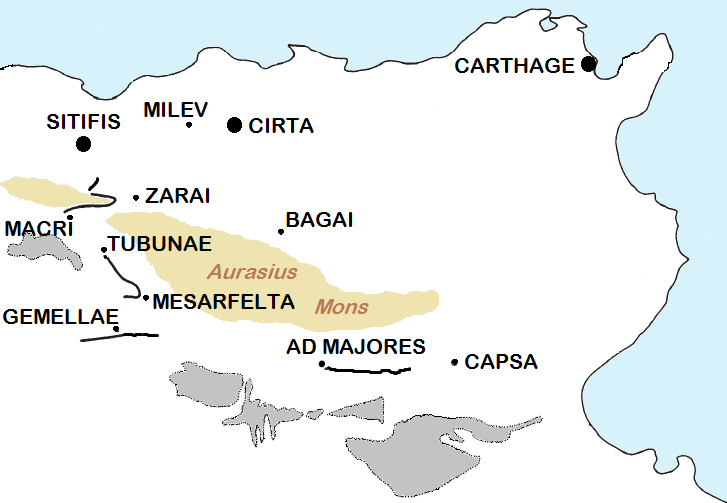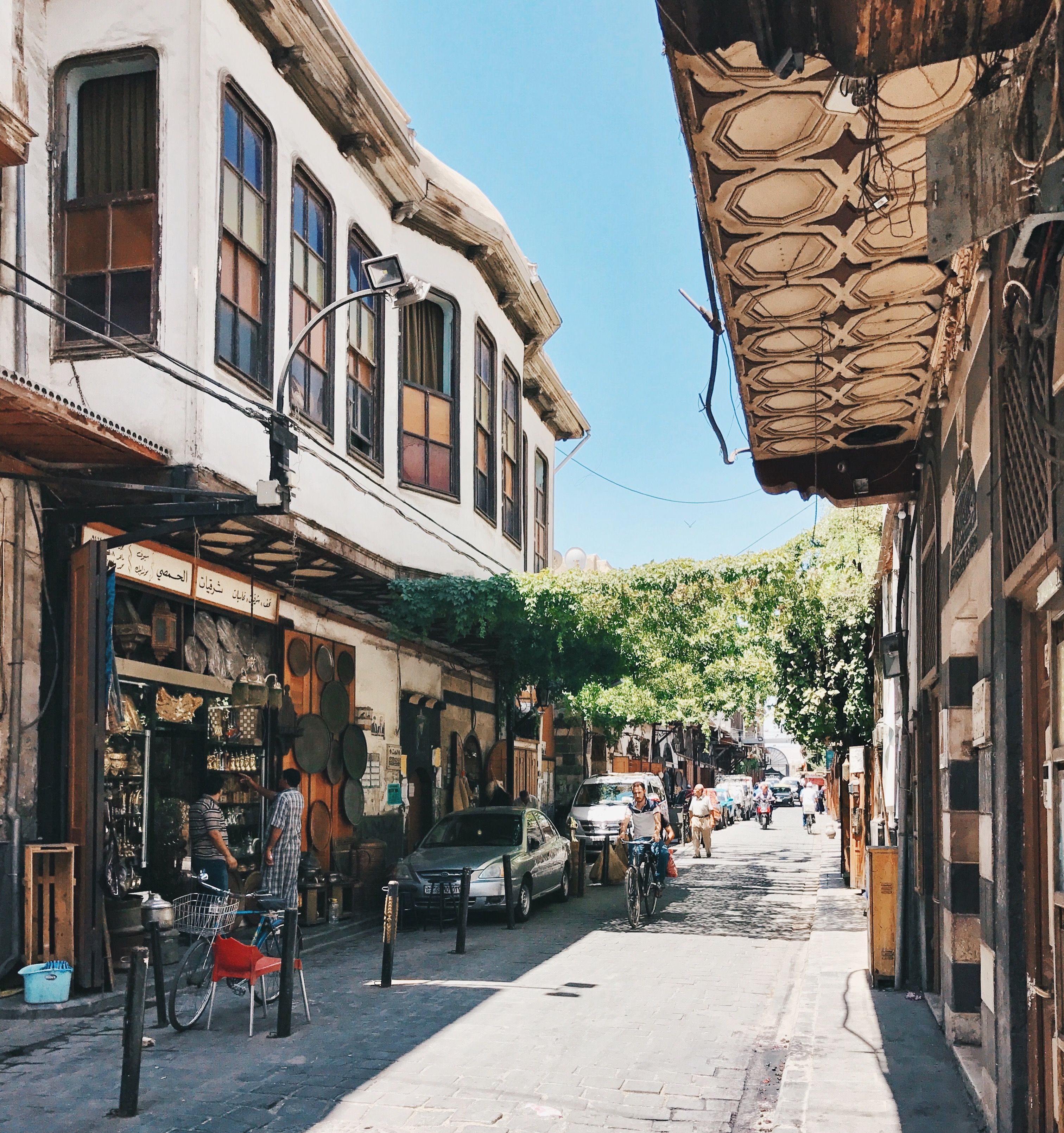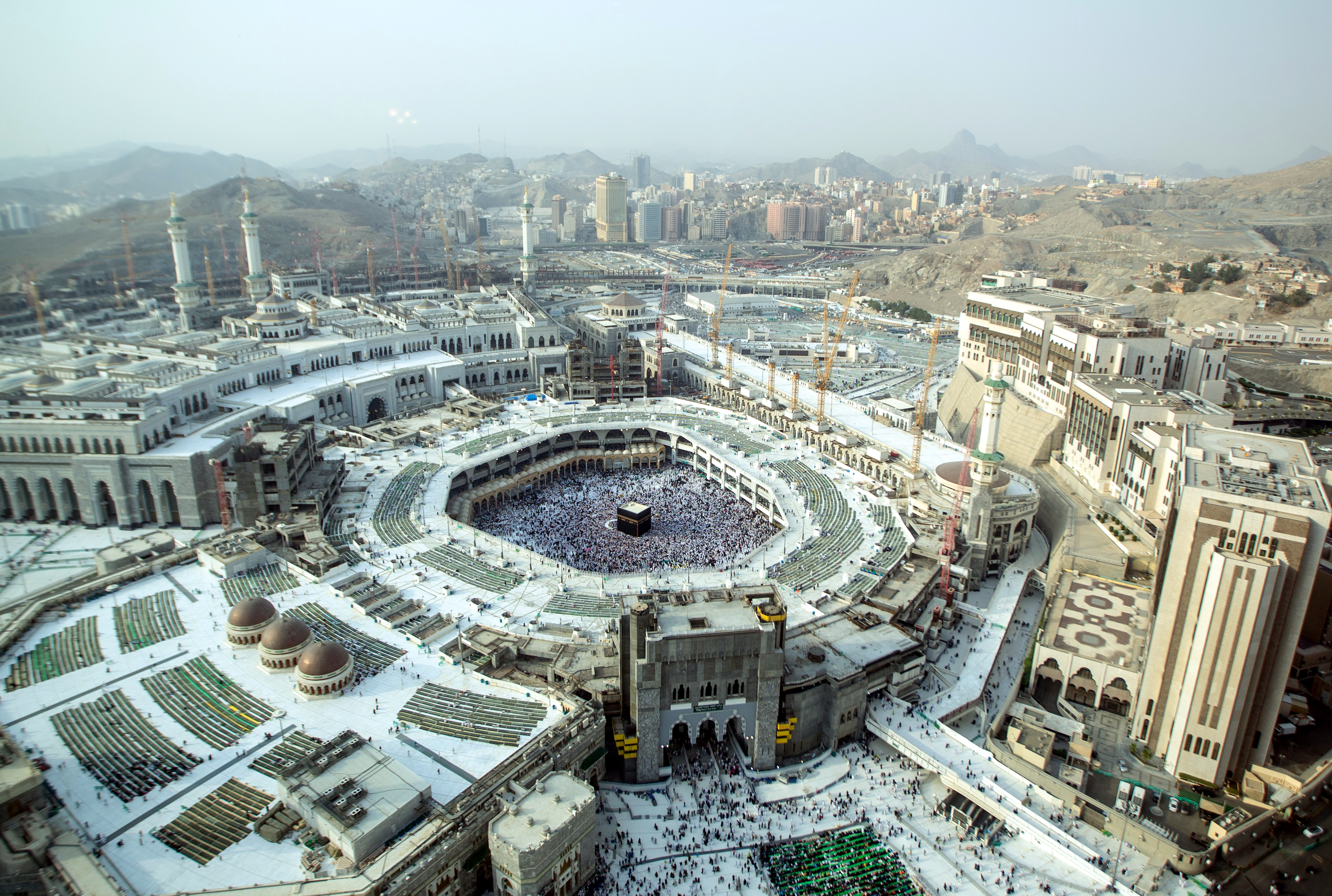|
Tubunae
Tobna (), also known by the ancient names of Tubunae or Thubunae, is a ruined former city in Batna Province of Algeria, located just south of the modern city of Barika. From this position, it once controlled the eastern part of the Hodna region, while M'Sila did the west. It flourished from the time of the Roman Empire through the Islamic Middle Ages until it was sacked and destroyed by the Banu Hilal in the 11th century, after which it was finally abandoned. Poorly documented by archaeologists today, Tobna's ruins occupy an extensive area and include the remains of a Byzantine fortress as well as the traces of a wall covering a 950 m by 930 m area. History The site of Tobna is poorly studied by archaeologists as of 2019. The same is true of the surrounding Hodna region in general. Jean Baradez's aerial surveys in Algeria, published in 1949, provided the first aerial images of the site. From this data, he worked on reconstructing the Roman road network surrounding the city ... [...More Info...] [...Related Items...] OR: [Wikipedia] [Google] [Baidu] |
Septimius Severus
Lucius Septimius Severus (; ; 11 April 145 – 4 February 211) was Roman emperor from 193 to 211. He was born in Leptis Magna (present-day Al-Khums, Libya) in the Roman province of Africa. As a young man he advanced through cursus honorum, the customary succession of offices under the reigns of Marcus Aurelius and Commodus. Severus was the final contender to seize power after the death of the emperor Pertinax in 193 during the Year of the Five Emperors. After deposing and killing the incumbent emperor Didius Julianus, Severus fought his rival claimants, the Roman generals Pescennius Niger and Clodius Albinus. Niger was defeated in 194 at the Battle of Issus (194), Battle of Issus in Cilicia (Roman province), Cilicia. Later that year Severus waged a short punitive campaign beyond the eastern frontier, annexing the Osroene, Kingdom of Osroene as a new province. Severus defeated Albinus three years later at the Battle of Lugdunum in Roman Gaul, Gaul. Following the consolidation of ... [...More Info...] [...Related Items...] OR: [Wikipedia] [Google] [Baidu] |
Batna Province
Batna Province (, Latn, ar, Wilāyat Bātnah) is a provinces of Algeria, province of Algeria, in the region of Aurès. The capital is Batna (city), Batna. Localities in this province include N'Gaous, Merouana and Timgad. Belezma National Park is in the Belezma Range area of the province. Administrative divisions It is made up of 21 districts of Algeria, districts and 61 Communes of Algeria, municipalities. The districts are: # Aïn Djasser District, Aïn Djasser # Aïn Touta District, Aïn Touta # Arris District, Arris # Barika District, Barika # Batna District, Batna # Bouzina District, Bouzina # Chemora District, Chemora # Djezzar District, Djezzar # El Madher District, El Madher # Ichmoul District, Ichmoul # Menaâ District, Menaâ # Merouana District, Merouana # N'Gaous District, N'Gaous # Ouled Si Slimane District, Ouled Si Slimane # Ras El Aioun District, Ras El Aioun # Seggana District, Seggana # Seriana District, Seriana # T'Kout District, T'Kout # Tazoult District, ... [...More Info...] [...Related Items...] OR: [Wikipedia] [Google] [Baidu] |
Comes
''Comes'' (plural ''comites''), translated as count, was a Roman title, generally linked to a comitatus or comital office. The word ''comes'' originally meant "companion" or "follower", deriving from "''com-''" ("with") and "''ire''" ("go"). The special lasting meaning derives from the position of a follower within a ''comitatus'', which was a retinue, or group of followers, such as those of magnates. In some instances these were sufficiently large and/or formal to justify specific denomination, such as a "''cohors amicorum''". The word ''comes'' is the origin of the much later terms for counts within the medieval nobility, and counties as their territorial jurisdictions. Ancient Roman religion ''Comes'' was a common epithet or title that was added to the name of a hero or god in order to denote relation with another god. The coinage of Constantine I (emperor), Roman Emperor Constantine I declared him "''comes''" to Sol Invictus ("Unconquered Sun") ''qua'' god. Imperial Ro ... [...More Info...] [...Related Items...] OR: [Wikipedia] [Google] [Baidu] |
Arabs
Arabs (, , ; , , ) are an ethnic group mainly inhabiting the Arab world in West Asia and North Africa. A significant Arab diaspora is present in various parts of the world. Arabs have been in the Fertile Crescent for thousands of years. In the 9th century BCE, the Assyrians made written references to Arabs as inhabitants of the Levant, Mesopotamia, and Arabia. Throughout the Ancient Near East, Arabs established influential civilizations starting from 3000 BCE onwards, such as Dilmun, Gerrha, and Magan, playing a vital role in trade between Mesopotamia, and the Mediterranean. Other prominent tribes include Midian, ʿĀd, and Thamud mentioned in the Bible and Quran. Later, in 900 BCE, the Qedarites enjoyed close relations with the nearby Canaanite and Aramaean states, and their territory extended from Lower Egypt to the Southern Levant. From 1200 BCE to 110 BCE, powerful kingdoms emerged such as Saba, Lihyan, Minaean, Qataban, Hadhramaut, Awsan, and ... [...More Info...] [...Related Items...] OR: [Wikipedia] [Google] [Baidu] |
Turkish Bath
A hammam (), also often called a Turkish bath by Westerners, is a type of steam bath or a place of public bathing associated with the Islamic world. It is a prominent feature in the culture of the Muslim world and was inherited from the model of the Roman ''thermae.'' Muslim bathhouses or hammams were historically found across the Middle East, North Africa, al-Andalus (Islamic Iberia, i.e. Spain and Portugal), Central Asia, the Indian subcontinent, and in Southeastern Europe under Ottoman rule. In Islamic cultures the significance of the hammam was both religious and civic: it provided for the needs of ritual ablutions but also provided for general hygiene in an era before private plumbing and served other social functions such as offering a gendered meeting place for men and for women. Archeological remains attest to the existence of bathhouses in the Islamic world as early as the Umayyad period (7th–8th centuries) and their importance has persisted up to modern times. ... [...More Info...] [...Related Items...] OR: [Wikipedia] [Google] [Baidu] |
Decumanus Maximus
In Roman urban planning, a ''decumanus'' was an east–west-oriented road in a Roman city or '' castrum'' (military camp). The main ''decumanus'' of a particular city was the ''decumanus maximus'', or most often simply "the ''decumanus''". In the rectangular street grid of the typical Roman city plan, the ''decumanus'' was crossed by the perpendicular ''cardo'', a north–south street. In a military camp, the ''decumanus'' connected the Porta Praetoria (closest to the enemy) to the Porta Decumana (away from the enemy). In the center – called groma – of a city or ''castrum'', the ''decumanus maximus'' crossed the perpendicular ''cardo maximus'', the primary north–south road. The forum was normally located close to this intersection. Etymology ''Decumanus'' or ''decimanus'' was the Latin word for 'tenth'. This name is said to come from the fact that the ''via decumana'' or ''decimana'' (the "tenth") separated the Tenth Cohort from the Ninth in the legionary encampme ... [...More Info...] [...Related Items...] OR: [Wikipedia] [Google] [Baidu] |
Jama Masjid
A congregational mosque or Friday mosque (, ''masjid jāmi‘'', or simply: , ''jāmi‘''; ), or sometimes great mosque or grand mosque (, ''jāmi‘ kabir''; ), is a mosque for hosting the Friday noon prayers known as ''jumu'ah''.See: * * * * * * * * * It can also host the Eid prayers in situations when there is no '' musalla'' or '' eidgah'' available nearby to host the prayers. In early Islamic history, the number of congregational mosques in one city was strictly limited. As cities and populations grew over time, it became more common for many mosques to host Friday prayers in the same area. Etymology The full Arabic term for this kind of mosque is ''masjid jāmi‘'' (), which is typically translated as "mosque of congregation" or "congregational mosque". "Congregational" is used to translate ''jāmi‘'' (), which comes from the Arabic root "ج - م - ع" which has a meaning ‘to bring together’ or ‘to unify’ (verbal form: and ). In Arabic, the term is typically ... [...More Info...] [...Related Items...] OR: [Wikipedia] [Google] [Baidu] |
Sijilmassa
Sijilmasa (; also transliterated Sijilmassa, Sidjilmasa, Sidjilmassa and Sigilmassa) was a medieval Moroccan city and trade entrepôt at the northern edge of the Sahara in Morocco. The ruins of the town extend for five miles along the River Ziz in the Tafilalt oasis near the town of Rissani. The town's history was marked by several successive invasions by Berber dynasties. Up until the 14th century, as the northern terminus for the western trans-Sahara trade route, it was one of the most important trade centres in the Maghreb during the Middle Ages. History Foundation and early Middle Ages According to al-Bakri's ''Book of Routes and Places'', Sufrite Kharijites first settled the town in the wake of the Berber revolts against the Umayyads. Al-Bakri recounts that others joined these early settlers there, until they numbered around four thousand, at which point they laid the groundwork for the city. They elected a leader, 'Isa bin Mazid al-Aswad (the Black), to handle their af ... [...More Info...] [...Related Items...] OR: [Wikipedia] [Google] [Baidu] |
Kairouan
Kairouan (, ), also spelled El Qayrawān or Kairwan ( , ), is the capital of the Kairouan Governorate in Tunisia and a UNESCO World Heritage Site. The city was founded by the Umayyads around 670, in the period of Caliph Mu'awiya (reigned 661–680); this is when it became an important centre for Sunni Islamic scholarship and Quranic learning, attracting Muslims from various parts of the world. The Mosque of Uqba is situated in the city.Europa Publications "General Survey: Holy Places" ''The Middle East and North Africa 2003'', p. 147. Routledge, 2003. . "The city is regarded as a holy place for Muslims." Etymology The name ( ''al-Qayrawān'') is an Arabic word meaning "military group" or "caravan", borrowed early on from the Middle Persian word ''kārawān'' (modern Persian ''kârvân''), meaning "military column" (''kâr'' "people/military" + ''vân'' "outpost") or " caravan" (see caravanserai). In Berber, the city used to be called ''Tikirwan'', thought to be an adaptatio ... [...More Info...] [...Related Items...] OR: [Wikipedia] [Google] [Baidu] |
Al-Bakri
Abū ʿUbayd ʿAbd Allāh ibn ʿAbd al-ʿAzīz ibn Muḥammad ibn Ayyūb ibn ʿAmr al-Bakrī (), or simply al-Bakrī (c. 1040–1094) was an Arab Andalusian historian and a geographer of the Muslim West. Life Al-Bakri was born in Huelva, the son of the sovereign of a short-lived principality established there by his family when the Caliphate of Cordoba fell in 1031. Al-Bakri belonged to the Arab tribe of Bakr. When his father was deposed by al-Mu'tadid (1042–1069) of the ruler of Taifa of Seville, he then moved to Córdoba, where he studied with the geographer al-Udri and the historian Ibn Hayyan. He spent his entire life in Al-Andalus, most of it in Seville and Almeria. While in Seville, he was there when El Cid arrived to collect tributes from Alfonso VI. He died in Córdoba without ever having travelled to the locations of which he wrote. Works Al-Bakri wrote about Europe, North Africa, and the Arabian peninsula. Only two of his works have survived. His ''Mu'jam m� ... [...More Info...] [...Related Items...] OR: [Wikipedia] [Google] [Baidu] |
Ifriqiya
Ifriqiya ( '), also known as al-Maghrib al-Adna (), was a medieval historical region comprising today's Tunisia, eastern Algeria, and Tripolitania (roughly western Libya). It included all of what had previously been the Byzantine province of Africa Proconsularis and extended beyond it, but did not include the Mauretanias. To the south, Ifriqiya was bounded by the semi-arid lands and salt marshes named el-Djerid. The northern boundary fluctuated from as far north as Sicily to the North African coastline, and the western boundary usually reached Béjaïa. Ifriqiya is bordered to the west by the Central Maghreb, with which the borders are fluid depending on the chroniclers and the eras. The capital was briefly Carthage, then Kairouan, Qayrawan (Kairouan), then Mahdia, then Tunis. The Aghlabids, from their base in Kairouan, initiated the invasion of Southern Italy beginning in 827, and established the Emirate of Sicily, which lasted until it was conquered by the Normans, and the s ... [...More Info...] [...Related Items...] OR: [Wikipedia] [Google] [Baidu] |
Abu Bakr Al-Maliki
Abū Bakr ʿAbdallāh ibn Muḥammad ibn ʿAbdallāh al-Qurashī al-Qayrawānī al-Mālikī ( 1036–1057) was an Ifrīqiyan historian, Mālikī jurist and Ashʿarī theologian and traditionist. He played a major role in spreading Mālikism and Ashʿarism in Ifrīqiya. Al-Mālikī was born in Kairouan. His father, Muḥammad, was trained in '' sharīʿa'' (law) and ''ḥadīth'' (tradition) and wrote a biography of the jurist Abu 'l-Ḥasan al-Qābiṣī. Al-Mālikī studied in Kairouan under Abū Bakr ibn ʿAbd al-Raḥmān and Muḥammad ibn ʿAbbās al-Anṣārī, who died in 1036. After studying for a time in the emirate of Sicily, he taught in Kairouan, where al-Māzarī was one of his students. According al-Dabbāgh, writing over two centuries later, al-Mālikī remained in Kairouan after the Hilālī sack of 1057, when most other scholars decamped to Mahdia. He died sometime after this date, perhaps in 1081 or 1097. Only one work by al-Mālikī has survived, ''Riyā ... [...More Info...] [...Related Items...] OR: [Wikipedia] [Google] [Baidu] |






